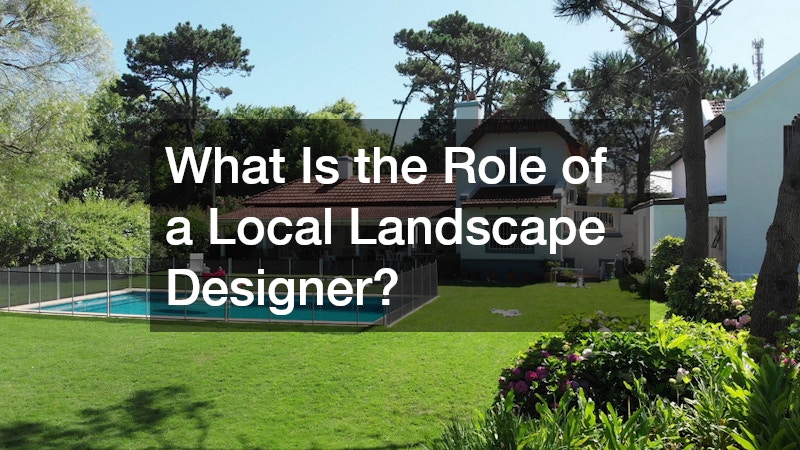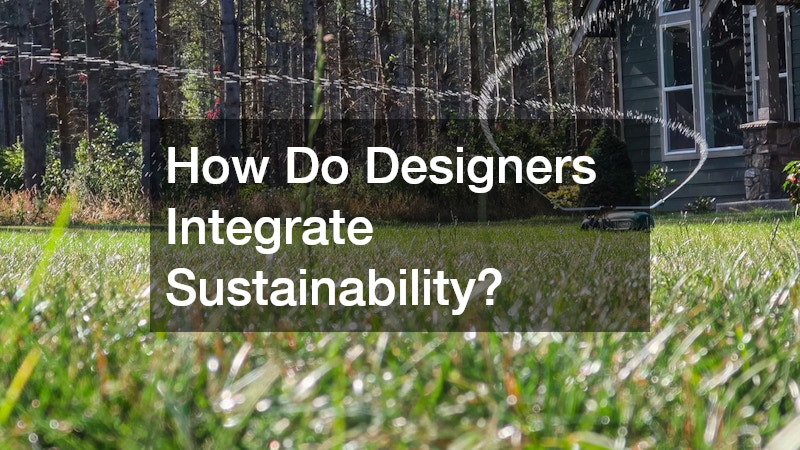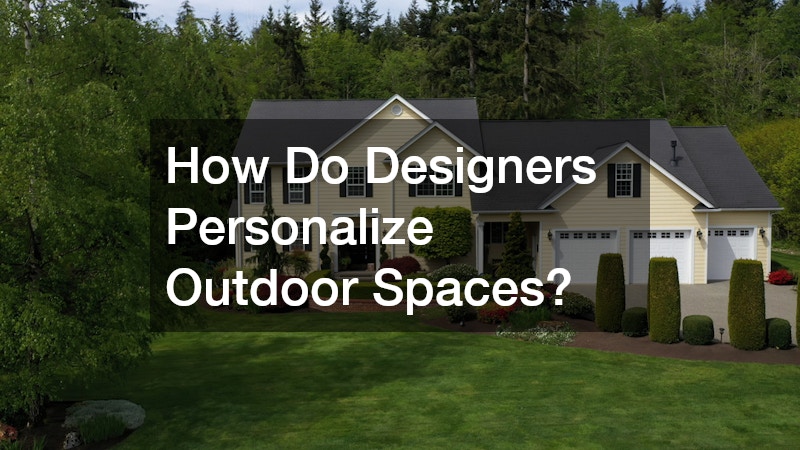Transforming outdoor spaces into beautiful, functional retreats requires more than just planting flowers or laying down sod. Local landscape designers play a crucial role in shaping gardens, patios, and yards into cohesive environments that reflect both nature’s beauty and the homeowner’s personality. These professionals bring expertise that goes far beyond aesthetics—they understand soil conditions, climate challenges, plant biology, and the technicalities of hardscaping and irrigation. Whether you want a peaceful backyard oasis, a kid-friendly garden, or an elegant outdoor entertaining area, local landscape designers guide every step of the process.
Utilizing their broad skill set, local landscape designers collaborate with other specialists, such as arborists and lawn care companies, to ensure every element, from tree cutting to irrigation systems, works in harmony. Their designs incorporate sustainable materials and techniques to protect the environment while enhancing curb appeal. In this article, we’ll explore the vital functions local landscape designers serve, how they plan and execute projects, the challenges they face, and the innovative technologies they use. If you’re considering upgrading your outdoor space, understanding the expertise of local landscape designers will help you appreciate the full scope of what they offer.
What Is the Role of a Local Landscape Designer?

Understanding Their Responsibilities
Local landscape designers are responsible for planning and designing outdoor spaces tailored to individual client needs. They assess the existing environment, consider aesthetic goals, and factor in practical requirements like drainage, sunlight, and accessibility. Unlike gardeners who primarily maintain plants, local landscape designers focus on the broader vision, creating blueprints that balance natural beauty with functionality. Their work may involve choosing plants, suggesting durable raised garden bed options, designing walkways, or recommending erosion control blankets for hillside stability.
The Difference Between Designers and Architects
While landscape architects tend to work on large-scale, complex projects requiring extensive technical knowledge and licensing, local landscape designers typically handle smaller residential or commercial spaces. Designers prioritize aesthetics and user experience and may collaborate with architects for structural elements. Understanding this distinction helps clients select the right professional for their project size and scope.
Collaborating with Other Professionals
Local landscape designers often coordinate with arborists, lawn care companies, and local tree companies to manage specific aspects such as tree cutting, local tree removal, or soil health. This collaboration ensures that each element of the design is sustainable and professionally executed, leading to a seamless, well-maintained outdoor space.
How Do Local Landscape Designers Plan a Project?
Initial Consultation and Site Analysis
The planning process begins with a thorough consultation where the designer listens to client goals and preferences. Site analysis follows, which includes assessing soil quality, topography, existing vegetation, and microclimates. This helps identify opportunities and challenges that influence design choices, such as where erosion control blankets might be necessary or where irrigation lines should run.
Concept Development and Design Proposals
After gathering information, designers develop concept sketches or digital models to illustrate potential layouts. These proposals incorporate hardscape features, plant selections, and water management systems. Incorporating feedback from clients during this phase ensures the final plan aligns with their vision and practical needs.
Budgeting and Project Planning
Local landscape designers provide detailed cost estimates and timelines, helping clients budget effectively. They often suggest phased approaches to accommodate budgets, beginning with foundational elements like durable raised garden beds or essential tree services before moving to decorative features.
What Are the Key Elements of Landscape Design?
Incorporating Natural Elements
A successful design embraces existing natural elements such as mature trees, shrubs, and natural slopes. Preserving these features often requires collaboration with arborists to safely perform tree cutting or local tree removal while maintaining ecological balance. Retaining mature trees not only adds character to the landscape but also helps prevent soil erosion and provides natural shade that supports undergrowth. Thoughtful integration of these natural elements can create a sense of timelessness and continuity with the surrounding environment, making the outdoor space feel like an organic extension of the local ecosystem.
Utilizing Hardscapes Effectively
Hardscapes—like patios, pathways, and retaining walls—provide structure and durability. Using materials that complement the environment and homeowner preferences creates a cohesive look. Durable raised garden beds made from weather-resistant materials offer both functionality and aesthetic appeal. Hardscape elements also help define different zones within a yard, making the space more organized and usable. For example, stone or brick walkways guide foot traffic while minimizing soil compaction. Incorporating textured or colored materials enhances visual interest and can tie into architectural styles, ensuring the hardscape feels integrated rather than an afterthought.
The Importance of Water Features
Water features such as ponds, fountains, or waterfalls add tranquility and attract wildlife. Local irrigation companies can help install and maintain efficient watering systems to support these features without wasting resources. Beyond their aesthetic value, water features can serve practical purposes, such as providing sound masking to increase privacy or creating natural cooling effects during hot weather. Designers carefully plan the location and scale of these features to harmonize with other landscape elements. Incorporating recirculating pumps and rainwater harvesting into irrigation systems further promotes sustainability.
How Do Designers Integrate Sustainability?

Choosing Sustainable Materials
Sustainability is a growing focus among local landscape designers. They select materials with low environmental impact, such as recycled stone or sustainably harvested wood, ensuring longevity and minimal waste.
Adopting Water Conservation Techniques
Smart irrigation systems designed by local irrigation companies optimize water use, reducing waste and supporting drought-resistant plants. Erosion control blankets also prevent soil loss, maintaining landscape integrity.
Enhancing Local Biodiversity
By selecting native plants and creating habitats for pollinators, designers encourage biodiversity. This approach fosters healthier ecosystems and reduces the need for pesticides or fertilizers often used by lawn care companies.
How Do Landscape Designers Use Plants Effectively?
Selecting Suitable Plant Varieties
Choosing plants suited to the local climate and soil ensures sustainability and reduces maintenance. Designers often recommend a mix of trees, shrubs, and perennials that complement each other visually and functionally. Combining plants with varying heights, textures, and colors creates dynamic compositions that evolve through seasons. In addition to aesthetics, selecting species that are resistant to local pests and adaptable to microclimates helps minimize care needs. This strategy also supports healthy soil microbiomes and reduces dependency on chemical treatments.
Designing Seasonal Plant Layouts
Creating seasonal interest involves planning plant arrangements that bloom or change colors at different times of the year. This keeps the garden visually appealing year-round and encourages interaction with nature. Designers carefully sequence flowering times and foliage changes to maintain continuous appeal, balancing bold colors with subtle textures. Including evergreen plants adds structure during dormant months, while bulbs and early bloomers signal seasonal transitions. Thoughtful layering of plants ensures that the landscape has depth and movement, drawing attention to focal points throughout the year.
Maintaining Native Flora
Local landscape designers advocate for preserving native flora, which is well-adapted to the environment and supports local wildlife. This practice often involves careful tree cutting and pruning coordinated with a local arborist or tree services. Maintaining native plant health promotes ecological balance and resilience against invasive species. Designers encourage clients to avoid over-pruning, which can stress plants and reduce their ability to support pollinators. Regular monitoring and integrated pest management strategies help keep native flora thriving without heavy reliance on chemicals.
What Are the Challenges Faced by Local Landscape Designers?
Dealing with Climate Variations
Changing weather patterns and extreme conditions require designers to be adaptive, selecting resilient plants and materials that withstand heat, drought, or heavy rain.
Overcoming Site Limitations
Designers often work with challenging terrains, compacted soils, or limited sunlight. Solutions might include installing erosion control blankets on slopes or choosing shade-tolerant plants.
Meeting Client Expectations
Balancing design aspirations with budget and maintenance constraints can be difficult. Clear communication and phased project planning help manage expectations effectively.
How Do Designers Personalize Outdoor Spaces?

Understanding Client Lifestyle and Needs
Whether the client desires a space for entertaining, gardening, or relaxation, local landscape designers tailor designs to suit these lifestyles, ensuring spaces are both beautiful and practical. They gather detailed information about how clients use their yards, the types of activities they enjoy, and any mobility or accessibility needs. This personalized approach results in spaces that are not only visually appealing but also enhance everyday living.
Incorporating Personal Touches and Decor
Custom elements like fire pits, seating areas, or art installations reflect the client’s personality, creating a truly unique outdoor environment. Designers source materials and décor that resonate with client tastes, whether rustic, modern, or eclectic. Integrating lighting for ambiance and safety, as well as weather-resistant furnishings, extends usability into evenings and cooler months.
Creating Functional Outdoor Living Areas
Designers integrate features like patios, pergolas, or outdoor kitchens, turning yards into extensions of indoor living spaces. Local landscape designers also coordinate with lawn care companies and tree services to maintain these areas over time. Well-planned circulation routes, durable raised garden beds, and strategically placed shade elements ensure comfort and ease of use, making these outdoor spaces inviting and versatile.
What Technologies Aid Modern Landscape Designers?
Utilizing Landscape Design Software
Advanced design tools allow local landscape designers to create detailed 3D renderings and simulations, helping clients visualize their future space accurately. These tools facilitate quick adjustments based on client feedback and help identify potential issues before construction begins. They also assist in calculating material quantities and estimating costs more precisely.
Incorporating Smart Irrigation Systems
Local irrigation companies offer smart solutions that automate watering schedules based on weather data, soil moisture, and plant needs, improving efficiency. These systems help prevent overwatering and reduce water bills, while promoting healthier plants. Integration with smartphone apps allows remote monitoring and adjustments, adding convenience for homeowners.
Using Drones for Landscape Surveying
Drones provide aerial views for site analysis, capturing terrain details that enhance accuracy in planning and monitoring. High-resolution images reveal slope gradients, drainage patterns, and existing vegetation from perspectives difficult to achieve otherwise. This technology speeds up the survey process and provides data that can be used to create more effective erosion control plans and hardscape placements.
How Do Local Trends Influence Landscape Design?
Adapting Global Trends to Local Environments
Designers merge popular trends like minimalist gardens or edible landscapes with regional characteristics to create relevant, stylish outdoor spaces. They consider native plant palettes and climate-appropriate materials to adapt global ideas locally. This ensures designs are both trendy and sustainable.
Incorporating Community Preferences
Understanding local culture and neighborhood styles helps designers create spaces that fit seamlessly into their surroundings, fostering community pride. Whether the preference leans toward classic, modern, or rustic styles, designers respect these nuances while injecting creativity.
Working with Cultural Elements
Integrating cultural motifs or native plant species reflects client heritage and strengthens the connection between people and place. This might include specific plant varieties, patterns, or garden layouts that honor traditions, enhancing the emotional resonance of the space.
How Is Success Measured in Landscape Design Projects?

Client Satisfaction and Feedback
Ultimately, the success of any project hinges on how well the design meets client expectations and enhances their daily life. Positive feedback and referrals often reflect this satisfaction.
Aesthetic and Functional Evaluation
Beautiful designs that also address practical concerns like drainage, irrigation, and maintenance are highly valued. Designers often conduct follow-ups to ensure the landscape performs as intended.
Long-Term Impact on the Environment
Sustainable choices that preserve biodiversity and reduce resource consumption reflect a project’s positive environmental legacy. Healthy, thriving landscapes demonstrate the lasting benefits of thoughtful design.
Conclusion
Local landscape designers play a pivotal role in transforming outdoor spaces into personalized, sustainable, and stunning environments. Their expertise spans far beyond aesthetics, encompassing collaboration with arborists, lawn care companies, and local irrigation companies to address every detail, from tree cutting to erosion control blankets. By carefully selecting plants, incorporating durable raised garden beds, and adopting smart irrigation techniques, these professionals create landscapes that are both functional and environmentally conscious.
Navigating challenges like climate variability and site limitations, local landscape designers tailor each project to fit client lifestyles and budgets. They embrace modern technologies such as design software and drones to enhance precision and visualization. Trends are thoughtfully adapted to local contexts, ensuring each space reflects both current styles and community values. Whether you want a peaceful retreat or a lively entertaining area, partnering with local landscape designers guarantees a well-crafted outdoor space that thrives for years to come.


